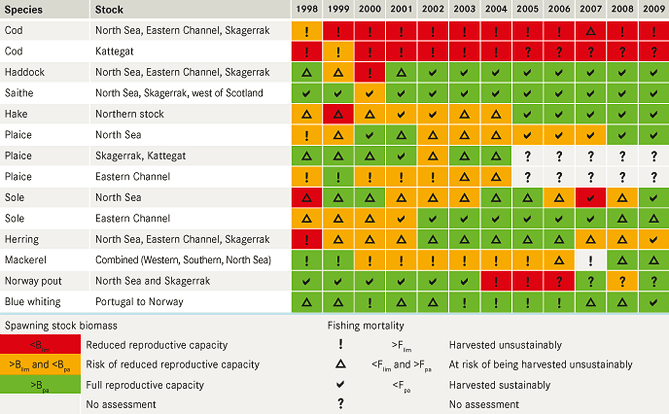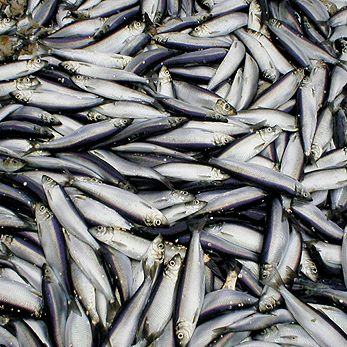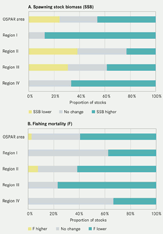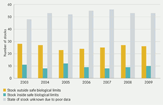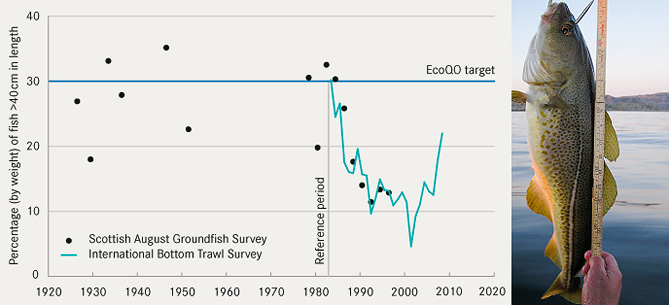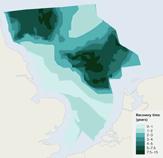In Region III, nearly all aspects of the demersal fish community have improved over the past decade, particularly in the north, to the extent that the community is now in a similar state to that observed when data were first available in the early 1980s. The size composition and the abundance/biomass/productivity of the community are, however, still of concern. In the pelagic community in Region III, there has been an increase in smaller pelagic fish as a result of fishing pressure on their predators.
In Region IV, bottom trawl data were only available for the French continental shelf. Most aspects of the fish community are in a poorer state than in the mid-1980s. There have been improvements in life-history trait composition and species richness over the past decade, but little change in other indicators.
In Region V, bottom trawl data were only available for the Rockall Bank Plateau area. Species diversity and the size composition of the demersal fish community have improved over the past decade, while the abundance/biomass/productivity has changed little.
Over the past decade the size composition, species richness and species evenness aspects of the demersal fish community have all improved in Regions II, III and V, while only species richness has improved in Region IV. There has been little change in the abundance/biomass/productivity aspects, while Regions III and IV showed an improvement in life-history trait composition. Currently four of the five aspects are generally on parity with the situation prevailing when data in each Region were first available; the exception being the size composition of the community. Here the assessment indicates that, despite recent improvements, a full recovery to earlier conditions has yet to be achieved.
Physical disturbance has increased in some areas and reduced in others
Heavy towed demersal fishing gears (e.g. beam trawls, otter trawls, scallop dredges) cause considerable physical damage to seabed habitats and communities. They are a major source of disturbance on the continental shelf to habitats such as horse mussel beds, sea-pen and burrowing megafauna communities and Sabellaria spinulosa reefs. Considerable damage has been caused to cold-water corals and seamounts in deep waters with an estimated 30% to 50% of cold-water coral areas impacted in the Norwegian Sea. On the shelf in Region II, beam trawling is reported to have reduced benthic biomass by 56% and benthic production by 21% compared to an unfished situation Figure 8.6. Set nets and longlines also affect fragile ecosystems that can take many decades to recover. Some of the remaining fragile habitats have been protected by closing fishing grounds. Although shallower, coarser and higher energy sediments in general recover faster than deeper water muds, trawling on sandbanks has also caused long-term changes.
The area disturbed by fisheries has increased in some Regions. This is the case for the Great Mud Bank (Grande Vasière) in the Bay of Biscay (Region IV). In the North Sea (Region II), although there has been a decline in overall hours fished, fishing effort has moved to areas that were previously lightly fished due to closures elsewhere. Nephrops trawling has increased by 65% in some areas. Displacement and changes in the distribution of fishing effort can have significant impacts due to local variations in the sensitivity of seabed habitats to disturbance. This has to be accounted for if large declines in previously heavily fished areas are offset by even slight increases in previously unfished or lightly fished areas.
Fishing activity affects the food web
Changes in fishing activity, discards and fish community structure affect the food web and in turn populations of predators and scavengers. These relationships are complex and often linked to other factors. In Region I, there is a close link in the population dynamics of cod, herring and capelin in the Barents Sea and hence overfishing of one species can have a strong effect on the food web. Currently the management of these stocks is well balanced. The increase in smaller pelagic fish in Region III, as a result of fishing pressure on their predators, has been linked to a decline in abundance of Calanus zooplankton. Climate factors are also implicated with an overall decline in zooplankton abundance of 70% in the North-East Atlantic since the 1960s.
In the northern North Sea, there is evidence that the regime shift in the composition and breeding cycle of Calanus zooplankton in the 1980s (C. finmarchicus progressively replaced by C. helgolandicus) has depressed the productivity of lesser sandeel. The breeding success of black-legged kittiwake in the northern part of Region II appears to be linked to variation in local sandeel abundance, and is susceptible to being depressed as a result of industrial fishing activities.
The distribution of seabirds at sea is influenced considerably by the supply of discards that are used as food for some scavenging species. In Region IV, a strong link has been shown between the demersal fishing fleet in the Gulf of Cadiz and the Cantabrian Sea and the distribution of scavenging seabirds.
There are indications that fishing has affected the genetic evolution of a number of fish species in the OSPAR area, particularly with regard to the onset of sexual maturation (cod in the North-East Arctic and cod, haddock and plaice in the North Sea), but there is no overall assessment of the effect on all exploited stocks.
Continue to "Fishing - What happens next?"
